What If? (7 page)
Authors: Randall Munroe

Th
is version of the periodic table is a little wider than you might be used to, since we’re inserting the lanthanide and actinide elements into rows 6 and 7. (
Th
ese elements are normally shown separately from the main table to avoid making it too wide.)
Th
e sixth row of the periodic table contains several radioactive elements, including promethium, polonium,
7
astatine, and
radon. Astatine is the bad one.
8
We don’t know what astatine looks like, because, as Lowe put it, “that stuff just doesn’t want to exist.” It’s so radioactive (with a half-life measured in hours) that any large piece of it would be quickly vaporized by its own heat. Chemists suspect that it has a black surface, but no one really knows.
Th
ere’s no material safety data sheet for astatine.
If there were, it would just be the word “NO” scrawled over and over in charred blood.
Our cube would, briefly, contain more astatine than has ever been synthesized. I say “briefly” because it would immediately turn into a column of superheated gas.
Th
e heat alone would give third-degree burns to anyone nearby, and the building would be demolished.
Th
e cloud of hot gas would rise rapidly into
the sky, pouring out heat and radiation.
Th
e explosion would be just the right size to maximize the amount of paperwork your lab would face. If the explosion were smaller, you could potentially cover it up. If it were larger, there would be no one left in the city to submit paperwork to.
Dust and debris coated in astatine, polonium, and other radioactive products would rain from the cloud,
rendering the downwind neighborhood completely uninhabitable.
Th
e radiation levels would be incredibly high. Given that it takes a few hundred milliseconds to blink, you would literally get a lethal dose of radiation in the blink of an eye.
You would die from what we might call “extremely acute radiation poisoning”
—
that is, you would be cooked.
Th
e seventh row would be much worse.

Th
ere are a whole bunch of weird elements along the bottom of the periodic table called
transuranic elements.
For a long time, many of them had placeholder names like “unununium,” but gradually they’re being assigned permanent names.
Th
ere’s no rush, though, because most of these elements are so unstable that they can be created only in particle accelerators and don’t exist
for more than a few minutes. If you had 100,000 atoms of Livermorium (element 116), after a second you’d have one left
—
and a few hundred milliseconds later, that one would be gone, too.
Unfortunately for our project, the transuranic elements don’t vanish quietly.
Th
ey decay radioactively. And most of them decay into things that
also
decay. A cube of any of the highest-numbered elements would
decay within seconds, releasing a tremendous amount of energy.
Th
e result wouldn’t be like a nuclear explosion
—
it
would
be a nuclear explosion. However, unlike a fission bomb, it wouldn’t be a chain reaction
—
just a reaction. It would all happen at once.
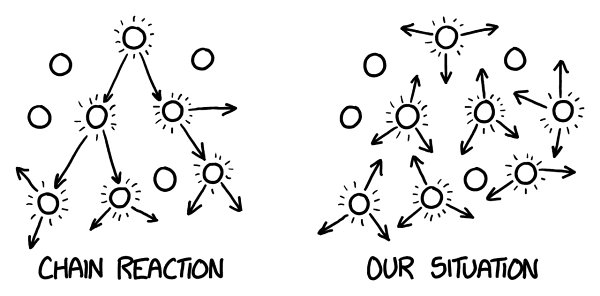
Th
e flood of energy would instantly turn you
—
and the rest of the periodic table
—
to plasma.
Th
e blast would be similar to that of a medium-sized nuclear detonation, but the radioactive fallout would be much, much worse
—
a veritable salad of everything on the periodic table turning into everything else as fast as possible.
A mushroom cloud would rise over the city.
Th
e top of
the plume would reach up through the stratosphere, buoyed by its own heat. If you were in a populated area, the immediate casualties from the blast would be staggering, but the long-term contamination from the fallout would be even worse.
Th
e fallout wouldn’t be normal, everyday radioactive fallout
9
—
it would be like a nuclear bomb that
kept exploding
.
Th
e debris would spread around the world,
releasing thousands of times more radioactivity than the Chernobyl disaster. Entire regions would be devastated; the cleanup would stretch on for centuries.
While collecting things is certainly fun, when it comes to chemical elements, you do
not
want to collect them all.
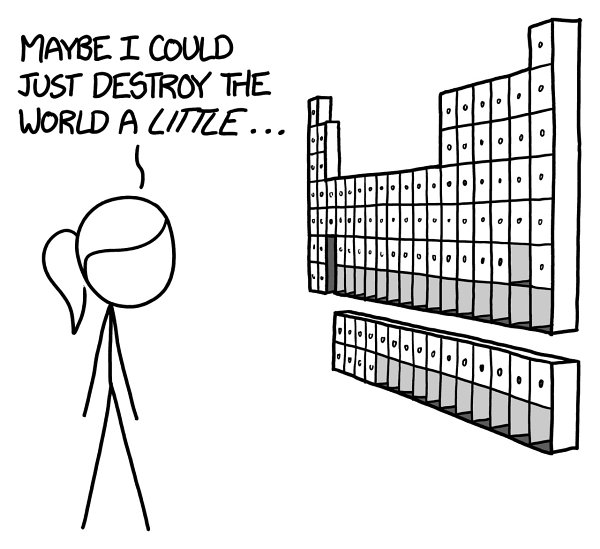
- 1
Th
ink of the elements as dangerous, radioactive, short-lived Pokémon.
- 2
An eighth row may be added by the time you read this. And if you’re reading this in the year 2038, the periodic table has ten rows but all mention or discussion of it is banned by the robot overlords.
- 3
Th
at is, assuming that they’re
in diatomic form (e.g. O
2
and N
2
). If the cube is in the form of single atoms, they’ll instantly combine, heating to thousands of degrees as they do.
- 4
Lowe is the author of the great drug research blog
In the Pipeline
.
- 5
A property that has led to its controversial use in incendiary artillery shells.
- 6
Search
YouTube for “gallium infiltration” to see how strange this is.
- 7
In 2006, an umbrella tipped with polonium-210 was used to murder former KGB officer Alexander Litvinenko.
- 8
Radon is the cute one.
- 9
You know, the stuff we all shrug off.
Everybody Jump
Q.
What would happen if everyone on Earth stood as close to each other as they could and jumped, everyone landing on the ground at the same instant?
—Thomas Bennett (and many others)
A.
Th
is is one of
the most popular questions submitted through my website. It’s been examined before, including by
ScienceBlogs
and
Th
e Straight Dope
.
Th
ey cover the kinematics pretty
well. However, they don’t tell the whole story.
Let’s take a closer look.
At the start of the scenario, the entire Earth’s population has been magically transported together into one place.

Th
is crowd takes up an area the size of Rhode Island. But there’s no reason to use the vague phrase “an area the size of Rhode Island.”
Th
is is our scenario; we can be specific.
Th
ey’re
actually
in Rhode Island.
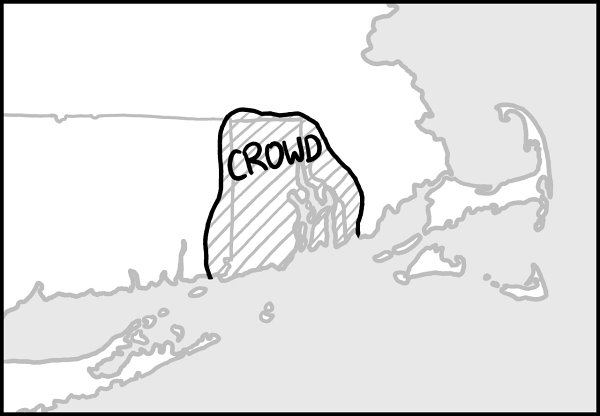
At the stroke of noon, everyone jumps.

As discussed elsewhere, it doesn’t really affect the planet. Earth outweighs us by a factor of over ten trillion. On average, we humans can vertically jump maybe half a meter on a good day. Even if the Earth were rigid and responded instantly, it would be pushed down by less than an atom’s width.
Next, everyone falls back to the ground.

Technically, this delivers a lot of energy into the Earth, but it’s spread out over a large enough area that it doesn’t do much more than leave footprints in a lot of gardens. A slight pulse of pressure spreads through the North American continental crust and dissipates with little effect.
Th
e sound of all those feet hitting the ground creates a loud, drawn-out roar lasting many
seconds.
Eventually, the air grows quiet.
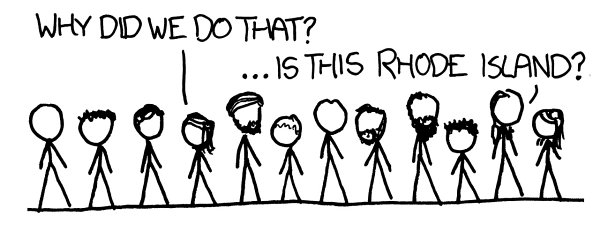
Seconds pass. Everyone looks around.
Th
ere are a lot of uncomfortable glances. Someone coughs.
A cell phone comes out of a pocket. Within seconds, the rest of the world’s five billion phones follow. All of them
—
even those compatible with the region’s towers
—
are displaying some version of “NO SIGNAL.”
Th
e cell networks have all collapsed under the unprecedented load. Outside
Rhode Island, abandoned machinery begins grinding to a halt.
Th
e T. F. Green Airport in Warwick, Rhode Island, handles a few thousand passengers a day. Assuming they got things organized (including sending out scouting missions to retrieve fuel), they could run at 500 percent capacity for years without making a dent in the crowd.
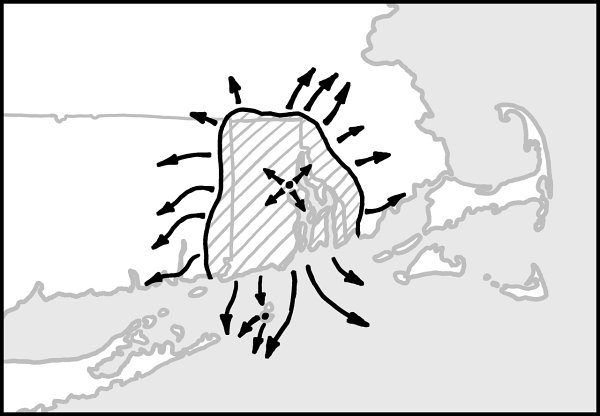
Th
e addition of all the nearby airports doesn’t change the equation much. Nor does the region’s light rail system. Crowds climb on board container ships in the deep-water port of Providence, but stocking sufficient food and water for a long sea voyage proves a challenge.
Rhode Island’s half-million cars are commandeered. Moments later, I-95, I-195, and I-295 become the sites
of the largest traffic jam in the history of the
planet. Most of the cars are engulfed by the crowds, but a lucky few get out and begin wandering the abandoned road network.
Some make it past New York or Boston before running out of fuel. Since the electricity is probably not on at this point, rather than find a working gas pump, it’s easier to just abandon the car and steal a new one. Who
can stop you? All the cops are in Rhode Island.
Th
e edge of the crowd spreads outward into southern Massachusetts and Connecticut. Any two people who meet are unlikely to have a language in common, and almost nobody knows the area.
Th
e state becomes a chaotic patchwork of coalescing and collapsing social hierarchies. Violence is common. Everybody is hungry and thirsty. Grocery stores are emptied.
Fresh water is hard to come by and there’s no efficient system for distributing it.
Within weeks, Rhode Island is a graveyard of billions.
Th
e survivors spread out across the face of the world and struggle to build a new civilization atop the pristine ruins of the old. Our species staggers on, but our population has been greatly reduced. Earth’s orbit is completely unaffected
—
it spins
along exactly as it did before our species-wide jump.
But at least now we know.
